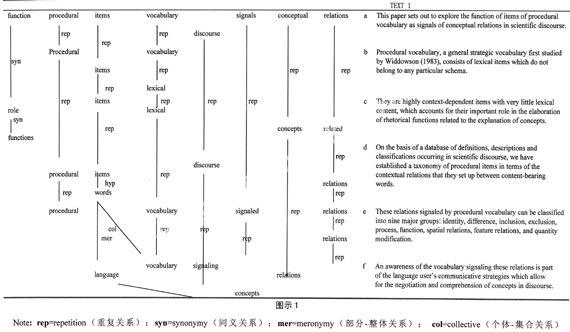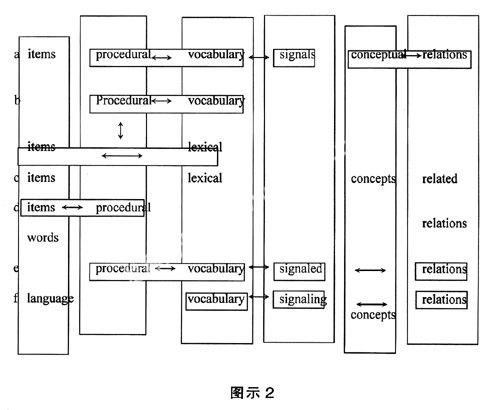词汇衔接模式与语篇体裁分析
于 晖
〔摘要〕文章探讨词汇衔接模式与语篇体裁目的之间的关系。首先我们提出一个词汇关系的分类系统,然后以一篇学术论文摘要为例构建语篇中的词汇链,多数词汇链是通过重复的手段建立起来的,这种重复在摘要中起到了强化的效果。每个词汇链的成分与其他词汇链中的成分交互作用表达语篇的整体信息,共同构建起语篇的语场,也使语篇的组织结构更为有机连贯。分析结果表明,摘要中主要的词汇链多与正文的主题内容有关,且常出现在题目中。这一发现表明,语篇的目的影响了其词汇结构,因为摘要的目的正是为了传递文章的主要信息。
〔关键词〕词汇衔接;语篇体裁;词汇链;衔接和谐
〔中图分类号〕 H0〔文献标识码〕A〔文章编号〕1008-2689(2008)02-0109-05
一、引言
在系统功能语法中,概念元功能在词汇—句法层面是由及物性系统实现的,而在语篇层面则是由词汇衔接(lexical cohesion)系统来实现的。在本文中,我们以一则摘要为例探讨词汇衔接模式与学术语篇体裁目的之间的关系。首先我们提出一个词汇关系的分类系统,并介绍了Hasan的衔接和谐(cohesive harmony)的概念,通过对这则摘要的分析来看词汇衔接模式能否在一定程度上反映体裁的目的。
二、词汇关系分类法
传统语言学对词汇的研究恐怕要数词典或同义词典的编纂了。在系统功能语言学的领域内,对词汇的研究最早可以追溯到弗斯[1]对搭配(collocation)现象的论述。所谓搭配,就是指一组词构成了相互预期(mutually expectant)的横组合关系,如“夜晚”常和“漆黑”搭配,“冬天”会使人预期“寒冷”等等。弗斯建议从两个角度来研究词汇意义、搭配和语境。对词汇搭配的研究可以看出词汇经常发生的语境,而对语境的研究则可以预期词汇可能的搭配。因而,两者的研究是互补的。
当代系统功能语言学的创始人Halliday[2][3][4]发展了弗斯的词汇思想观,早在六十年代就提出可以把词汇纳入到语法体系中去。他的关于词汇的论述已成为系统语言学的经典名句:“语法学家的梦想是(而且必须是,这正是语法的性质)领土的不断扩张。他愿意把所有的语言形式都转化为语法,并希望能证明词汇也可被定义为‘最细微的语法[2](267)。”在以后的研究中,一些系统语言学家纷纷致力于实现这一“语法学家的梦想”[5][6][7]。
词汇在语篇层面体现出来的就是词汇衔接模式。Halliday & Hasan 早在1976年就在《英语中的衔接》[8]一书中对衔接现象做了详尽的阐述,至今仍被奉为研究衔接理论的经典著作。他们在该书中提出了五种词汇关系:(1)重复(如book-book);(2)同义词(如book-volume);(3)笼统词(如thing-item);(4)上义词(如flower-rose);(5)搭配词(如dark-night)。我们的研究主要建立在Martin[9]提出的词汇关系系统上,包括三种主要类型:分类型(taxonomic)、核心型(nuclear)、序列型(activity sequence)。分类型词汇关系包括上下义、反义词、同义词等,如花—玫瑰、买—卖、书房—书斋等等。核心型词汇关系涉及参与者、地点、事物和过程的组合,如狮子—吼、慢慢—走、瞄准—靶心等,这种词汇类型包含了一种相互预期的关系。序列型词汇关系指一系列事件或过程的组合,这种组合也包含了相互预期的关系,如患感冒—看医生、浸泡水中—融化、踢球—射门等。
本文重点探讨语篇中的分类型词汇关系。语篇中所有发生关系的词汇构成了一条词汇链,所有词汇链代表了语篇整体的词汇结构。语篇中每个词汇链揭示了某个主题或部分主题,对语篇中词汇链的分析和描述有可能帮助读者识别整个语篇所讨论的内容。因而,对语篇词汇结构的分析有助于我们了解语篇中词汇和高于语篇的符号层面——语场之间的关系。通过分析语篇的整体词汇结构,我们可以解释作者是如何构建语篇中所体现的社会活动行为的。
三、衔接和谐(cohesive harmony)
衔接和谐的概念最早由Hasan[10]提出,涉及衔接链(cohesive chain)和衔接链的交互作用(chain interaction),用于分析语篇的衔接和连贯性。在本节中,我们以一则学术杂志论文的摘要为例来说明如何解析衔接链和衔接链的交互作用,以此分析语篇衔接与连贯更深层的原因。例文如下:
aThis paper sets out to explore the function of items of procedural vocabulary as signals of conceptual relations in scientific discourse.
bProcedural vocabulary, a general strategic vocabulary first studied by Widdowson (1983), consists of lexical items which do not belong to any particular schema.
cThey are highly context-dependent items with very little lexical content, which accounts for their important role in the elaboration of rhetorical functions related to the explanation of concepts.
dOn the basis of a database of definitions, descriptions and classifications occurring in scientific discourse, we have established a taxonomy of procedural items in terms of the contextual relations that they set up between content-bearing words.
eThese relations signaled by procedural vocabulary can be classified into nine major groups: identity, difference, inclusion, exclusion, process, function, spatial relations, feature relations, and quantity modification.
fAn awareness of the vocabulary signaling these relations is part of the language users communicative strategies which allow for the negotiation and comprehension of concepts in discourse.
(一)词汇还原(lexical rendering)
词汇还原包括把人称代词转化为原有的名词,并把省略或被替代的词也还原为原有的词汇。如下例:
语篇原文
bProcedural vocabulary, a general strategic vocabulary first studied by Widdowson (1983), consists of lexical items which do not belong to any particular schema.
cThey are highly context-dependent items with very little lexical content, which accounts for their important role in the elaboration of rhetorical functions related to the explanation of concepts.
还原语篇
bbProcedural vocabulary, a general strategic vocabulary first studied by Widdowson (1983), consists of lexical items which do not belong to any particular schema.
ccProcedural vocabularies are highly context-dependent items with very little lexical content, which accounts for the important role of procedural vocabulary in the elaboration of rhetorical functions related to the explanation of concepts.
词汇还原还涉及语法隐喻现象。许多语言学家都曾对语法隐喻现象进行深入地探讨。语法隐喻大量出现在科技学术文献中,以达到浓缩信息,使语言凝练、高度抽象化和概念化的目的。实现语法隐喻的一种方式就是名词化过程(nominalization),即用名词形式来表达一个过程的意义。在下面的例子中,我们把名词signal视为动词signaling和signaled的重复,这是因为,名词signal的非标记性的实现方式本应是一个动作过程而非一个名词。
aThis paper sets out to explore the function of items of procedural vocabulary as signals of conceptual relations in scientific discourse.
eThese relations signaled by procedural vocabulary can be classified into nine major groups
fAn awareness of the vocabulary signaling these relations is part of the language users communicative strategies

尽管我们在还原语法隐喻的过程中可能会部分改变语篇的语式,但对于语篇语场的分析却不仅没有大的影响,还可以帮助我们更深入地了解语篇所体现的社会行为活动。
在还原词汇的过程中,我们把同一个词的派生词也视为词汇衔接中的重复。lexical一词的情况有些特殊,我们把它划归在由vocabulary形成的词汇链中,这是因为vocabulary的形容词形式仅由lexical一词实现。另一方面,如果同一形式的两个单词的所指内容不同,那么这两个单词就不能划分在同一个词汇链中。这就是为什么我们没有把e小句中的function划归在以function一词为核心形成的词汇链中,因为前者表示九种procedural vocabulary中的一种类型,而后者表示“功能、角色”等涵义。从这一点而言,我们也可以认为衔接这一概念的本质是语义关联,而非简单的形式关联。
在还原词汇的基础上,我们构建出例文中的词汇链,如图示1所示。
(二)词汇链的互动
词汇链通常并不单独存在于一个语篇之中,而是与其它词汇链共存。单纯构建词汇链只是可以帮助我们部分解释语篇的连贯性,我们仍然需要进一步解析各个词汇链之间是如何相互作用来共同传递语篇所要表达的信息的。Hasan[10](91)认为“词汇链形成互动的最低要求就是一个词汇链中至少有两个成员与另外一个词汇链中的两个成员形成相同的语义关系(‘A minimum requirement for chain interaction is that at least two members of one chain should stand in the same relation to two members of another chain)。”我们利用Martin[9](320)提出的核心型词汇关系来考察例文中词汇链的相互作用,图示2描述了语篇中所有发生关系的词汇链。
第一条词汇链以items为主线,分别与其它词汇链中的lexical和procedural构成了形容语^事物(Epithet ^ Thing)的结构。一方面,items与procedural构成了名词性词组,表明items与vocabulary 的词义接近(试比较procedural vocabulary与procedural items)。另一方面,items与lexical构成了一个名词性词组,表明它有可能是集合名词vocabulary中的某个个体单位。在b小句中procedural vocabulary和lexical items形成了载体:属性(Carrier:Attribute)的关系,进一步说明lexical items与procedural vocabulary构成了包蕴的关系。这条词汇链几乎贯穿全文,提示我们这则摘要语篇可能与lexical items有主要关系,或者说与其中一种lexical item有关。
第二和第三条词汇链中的procedural和vocabulary多次发生交互作用构成形容语^事物的结构,作用后产生的这个词汇结构又多次作为施为者(agent)出现在语篇的各种行为过程中。这两个词汇链的存在提示读者procedural vocabulary与语篇的主要内容有关。因为我们所选取的例文是一则摘要,那么可以预测procedural vocabulary很有可能与论文的主要论述内容有关。值得指出的是,这个词汇组合同样出现在论文标题这个醒目的位置,更加说明procedural vocabulary在全文论述中的重心位置了。
第四条词汇链完全由表示行为过程的signal组成,正如procedural vocabulary一样,signal也出现在正文的标题中。signal还担负起连接procedural vocabulary与relations的责任,三者形成了施为者^过程^介质的结构。

第六条词汇链也是最后一条词汇链以relations为主线。它与前一个词汇链中的conceptual作用构成了形容语^事物的结构。其它情况下,relations多经由signal与procedural vocabulary发生联系。
通过对词汇链及其之间相互作用的分析,我们基本可以推断出论文正文的主要信息内容,即“procedural vocabulary signal conceptual relations”。为什么在短短一则摘要语篇中就能体现出如此明确显著的信息?我们认为这正是由摘要的目的决定的。摘要的目的就是高度凝练论文的主要内容,帮助读者在短时间内掌握论文主要信息,进而引导读者进一步阅读正文。
四、结论
在本文中,我们以一篇摘要为例探讨Hasan提出的衔接和谐问题。首先我们对语篇进行词汇还原,即把代词还原为被指代的名词,并把替代或是省略的词汇还原等等。单单分析语篇中的词汇链来解释衔接还远远不够,这就要求我们还要进一步分析词汇链之间是如何交互作用表达语篇的全部信息的。分析结果表明,摘要中主要的词汇链多与正文的主题内容有关,且常出现在题目中。所有的词汇链共同构建起语篇的语场。多数词汇链是通过重复的手段建立起来的,这种重复在摘要中可能起到了强化的效果。每个词汇链的成分与其它词汇链中的成分交互作用,使语篇的组织结构更为有机连贯。
在整体分析摘要的词汇结构时,词汇衔接模式与语篇体裁之间确实存在一定的关系。摘要中主要的词汇链体现了文章的主要信息。这一发现表明,语篇的目的影响了其词汇结构,因为摘要的目的正是为了传递文章的主要信息。
〔参考文献〕
[1]Firth, J. R. Papers in Linguistics 1934-1951[M]. London: Oxford University Press, 1957.
[2]Halliday, M. A. K. Categories of the theory of grammar [J]. Word, 1961, 17(3): 241-92.
[3]Halliday, M.A.K. An Introduction to Functional Grammar(2nd edn.) [M].London: Edward, 1994.
[4]Halliday, M. A. K. & Matthiessen, C. An Introduction to Functional Grammar (3rd edn.) [M]. London:Edward, 2004.
[5]Hasan, R. The grammarians dream: lexis as most delicate grammar [A]. InHalliday,M. A. K. & Fawcett R.P. (eds.). New Developments in Systemic Linguistics. Vol. 2: Theory and Application [C]. London: Pinter, 1987:184-211.
[6]Berry, M. Introduction to Systemic Linguistics 1 & 2 [M]. London: Batsford, 1977.
[7]Fawcett, R.P. Cognitive Linguistics and Social Interaction: Towards an Integrated Model of a Systemic Functional Grammar and the Other Components of an Interacting Mind [M].Heidelberg: Julius Groos and Exeter University, 1980.
[8]Halliday, M. A. K. & Hasan, R. Cohesion in English [M]. London: Longman, 1976.
[9]Martin, J. R. English Text: System and Structure [M]. Amsterdam: John Benjamins, 1992.
[10]Halliday, M. A. K. & Hasan, R. Language, Context and Text: Aspects of Language in a Social-SemioticPerspective [M]. Victoria: Deakin University, 1985.
(责任编辑:何伟)
Lexical Cohesion Patterns and Genre Analysis
YU Hui
(School of Foreign Languages and Literatures Beijing Normal University,
Beijing 100875, China)
Abstract: In this paper, we talk about the lexical cohesion patterns of a text in relation to its genre. First we present a simplified taxonomy of lexical relations mainly based on Martin (1992). Based on the taxonomy, we have illustrated how lexical items in an abstract form lexical strings and how lexical strings interact with each other. Lexical strings together build up a topic focus, i.e. the Field of the text. The result of our analysis shows that the major lexical strings in an abstract reflect the essential messages of the article and some of them may also appear in the title of the article. This finding helps to confirm our postulation that lexical realizations in a text are conditioned by the genre of the text. The purpose determines the genre of a text, and the purpose is, presumably, reflected at all levels of linguistic realizations of the text, as the purpose of an abstract is to introduce the essential messages of the source article.
Key words: lexical cohesion; genre; lexical chain; cohesive harmony

